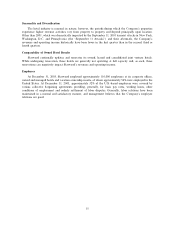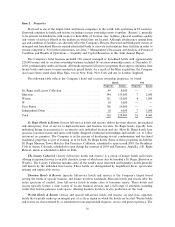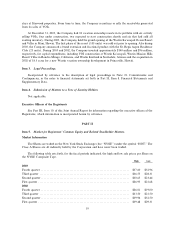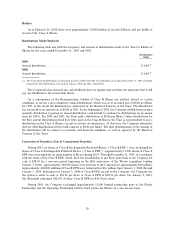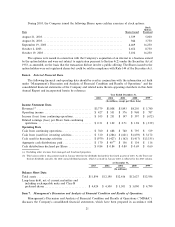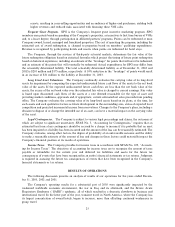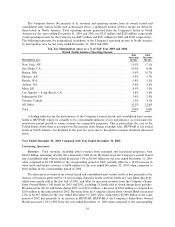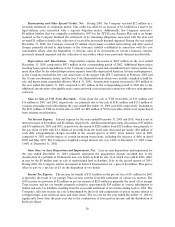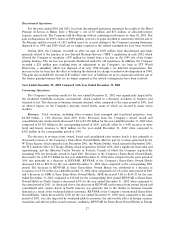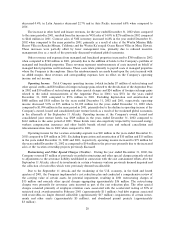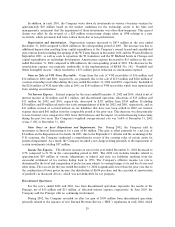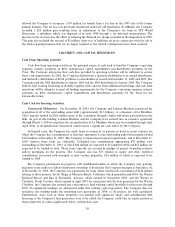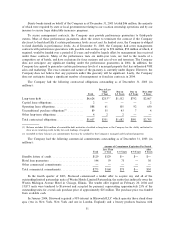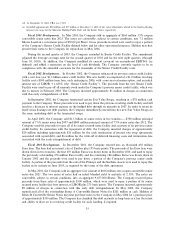Starwood 2003 Annual Report Download - page 33
Download and view the complete annual report
Please find page 33 of the 2003 Starwood annual report below. You can navigate through the pages in the report by either clicking on the pages listed below, or by using the keyword search tool below to find specific information within the annual report.resorts, resulting in cross-selling opportunities and an audience of higher-end purchasers, yielding both
higher revenues and reduced risks associated with Ñnancing these VOI sales.
Frequent Guest Program. SPG is the Company's frequent guest incentive marketing program. SPG
members earn points based on spending at the Company's properties, as incentives to Ñrst time buyers of VOIs
and, to a lesser degree, through participation in aÇliated partners' programs. Points can be redeemed at most
Company owned, leased, managed and franchised properties. The cost of operating the program, including the
estimated cost of award redemption, is charged to properties based on members' qualifying expenditures.
Revenue is recognized by participating hotels and resorts when points are redeemed for hotel stays.
The Company, through the services of third-party actuarial analysts, determines the fair value of the
future redemption obligation based on statistical formulas which project the timing of future point redemption
based on historical experience, including an estimate of the ""breakage'' for points that will never be redeemed,
and an estimate of the points that will eventually be redeemed. Actual expenditures for SPG may diÅer from
the actuarially determined liability. The total actuarially determined liability as of December 31, 2003 and
2002 is $201 million and $175 million, respectively. A 10% reduction in the ""breakage'' of points would result
in an increase of $31 million to the liability at December 31, 2003.
Long Lived Asset Valuations. The Company continually evaluates the carrying value of its long-lived
assets for impairment by comparing the expected undiscounted future cash Öows of the assets to the net book
value of the assets. If the expected undiscounted future cash Öows are less than the net book value of the
assets, the excess of the net book value over the estimated fair value is charged to current earnings. Fair value
is based upon discounted cash Öows of the assets at a rate deemed reasonable for the type of asset and
prevailing market conditions, appraisals and, if appropriate, current estimated net sales proceeds from pending
oÅers. The Company evaluates the carrying value of its long-lived assets based on its plans, at the time, for
such assets and such qualitative factors as future development in the surrounding area, status of expected local
competition and projected incremental income from renovations. Changes to the Company's plans, including a
decision to dispose of or change the intended use of an asset, can have a material impact on the carrying value
of the asset.
Legal Contingencies. The Company is subject to various legal proceedings and claims, the outcomes of
which are subject to signiÑcant uncertainty. SFAS No. 5, ""Accounting for Contingencies,'' requires that an
estimated loss from a loss contingency should be accrued by a charge to income if it is probable that an asset
has been impaired or a liability has been incurred and the amount of the loss can be reasonably estimated. The
Company evaluates, among other factors, the degree of probability of an unfavorable outcome and the ability
to make a reasonable estimate of the amount of loss and changes in these factors could materially impact the
Company's Ñnancial position or its results of operations.
Income Taxes. The Company provides for income taxes in accordance with SFAS No. 109, ""Account-
ing for Income Taxes''. The objectives of accounting for income taxes are to recognize the amount of taxes
payable or refundable for the current year and deferred tax liabilities and assets for the future tax
consequences of events that have been recognized in an entity's Ñnancial statements or tax returns. Judgment
is required in assessing the future tax consequences of events that have been recognized in the Company's
Ñnancial statements or tax returns.
RESULTS OF OPERATIONS
The following discussion presents an analysis of results of our operations for the years ended Decem-
ber 31, 2003, 2002 and 2001.
The Company's operating results for a substantial part of 2003 were signiÑcantly impacted by the
weakened worldwide economic environment, the war in Iraq and its aftermath, and the Severe Acute
Respiratory Syndrome (""SARS'') epidemic, all of which resulted in a dramatic slowdown in business and
international travel. In the latter part of the year, transient travel in North America, where the Company has
its largest concentration of owned hotels, began to increase, more than oÅsetting continued weaknesses in
group travel.
23




